Abstract
We designed a multicenter study to compare tobramycin/clindamycin to imipenem/cilastatin for intra-abdominal infections. We included the Acute Physiology and Chronic Health Evaluation (APACHE II) index of severity and excluded patients without established infection. Two hundred ninety patients were enrolled, of whom 162 were evaluable. Using logistic regression to analyze both outcome at the abdominal site of infection and outcome as mortality, we found a significant correlation for both with APACHE II score (p less than 0.0001 for both). Next we analyzed the residual effect of treatment assignment and found a significant improvement in outcome for imipenem/cilastatin-treated patients (p = 0.043). The differences in outcome were explained by a higher failure rate for patients with gram-negative organisms for tobramycin/clindamycin-treated patients (p = 0.018). This was reflected in a significantly higher incidence of fasciitis requiring reoperation and prosthetic fascial replacement. Maximum peak tobramycin levels were analyzed for 63 tobramycin/clindamycin patients harboring gram-negative organisms. For failures the maximum peak was 6.4 +/- 1.9 micrograms/mL, and time to maximum peak was 4.6 +/- 5.2 days. For successes the maximum peak was 6.1 +/- 1.7 micrograms/mL, occurring at 3.8 +/- 2.6 days. This study supports inclusion of severity scoring in statistical analyses of outcome results and supports the notion that imipenem/cilastatin therapy improves outcome at the intra-abdominal site of infection as compared to a conventionally prescribed amino-glycoside-based regimen.
Full text
PDF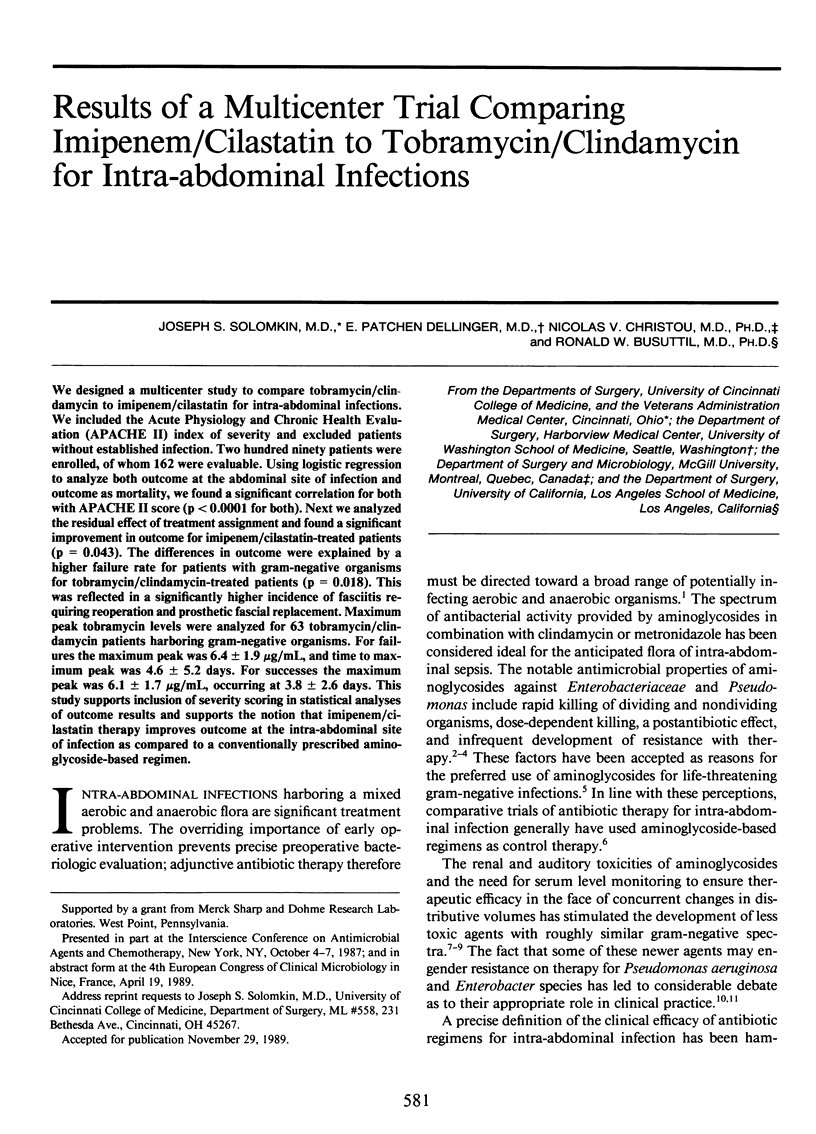
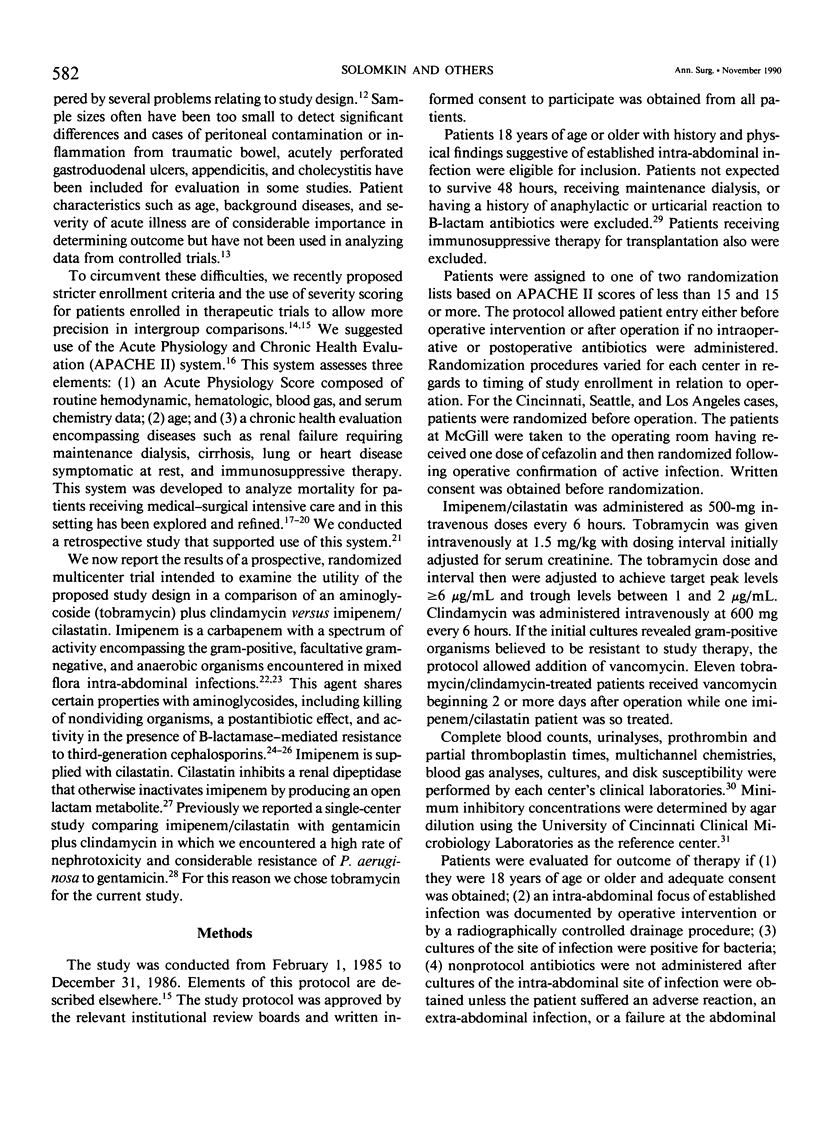
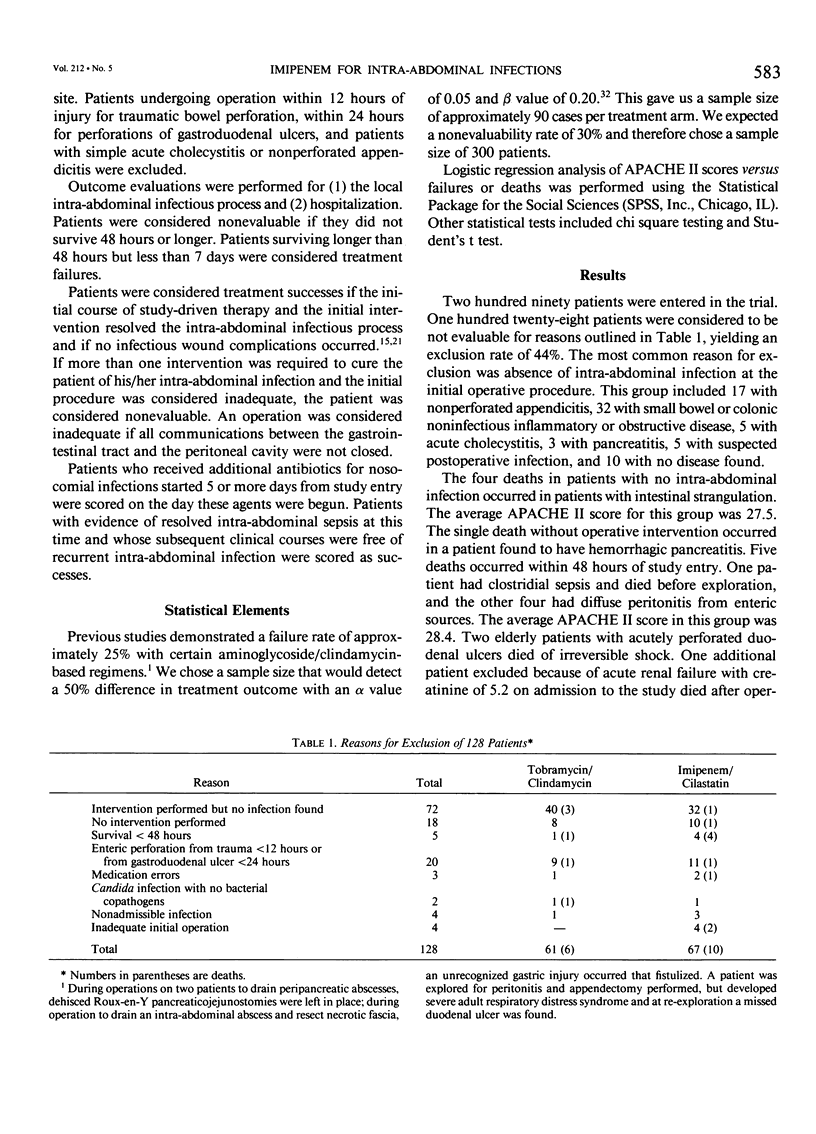

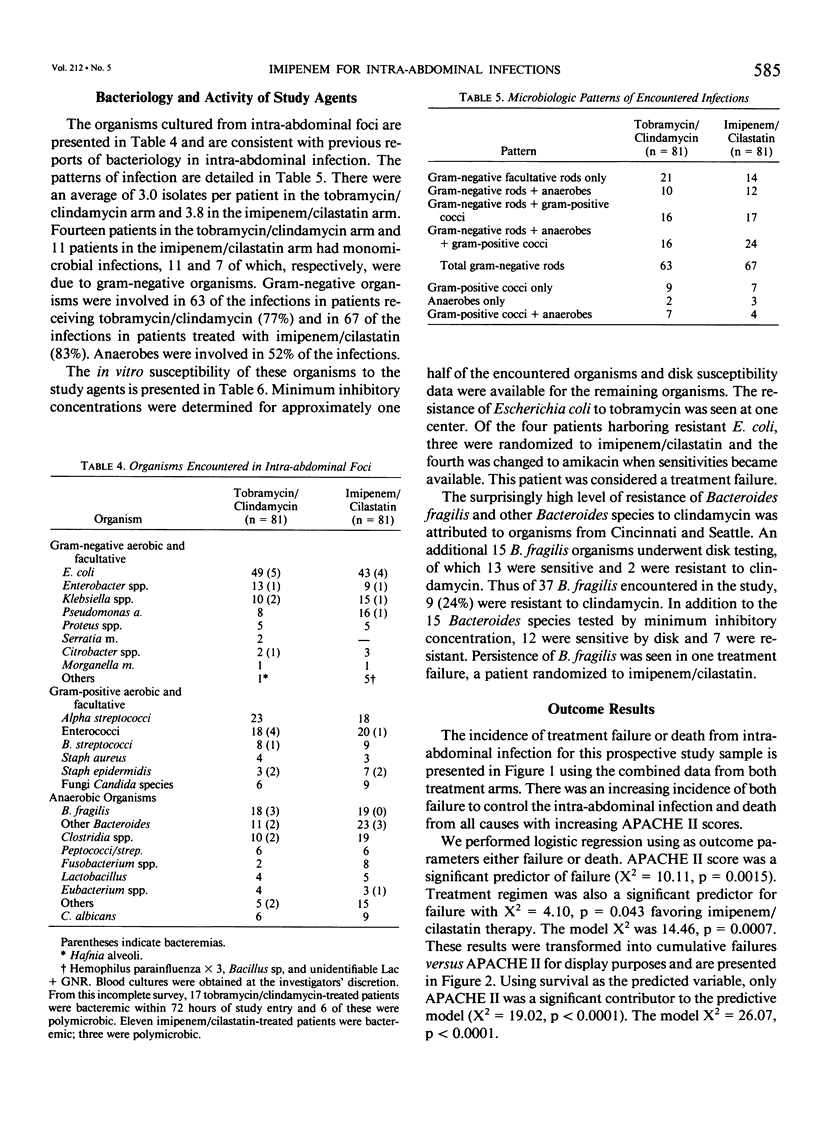
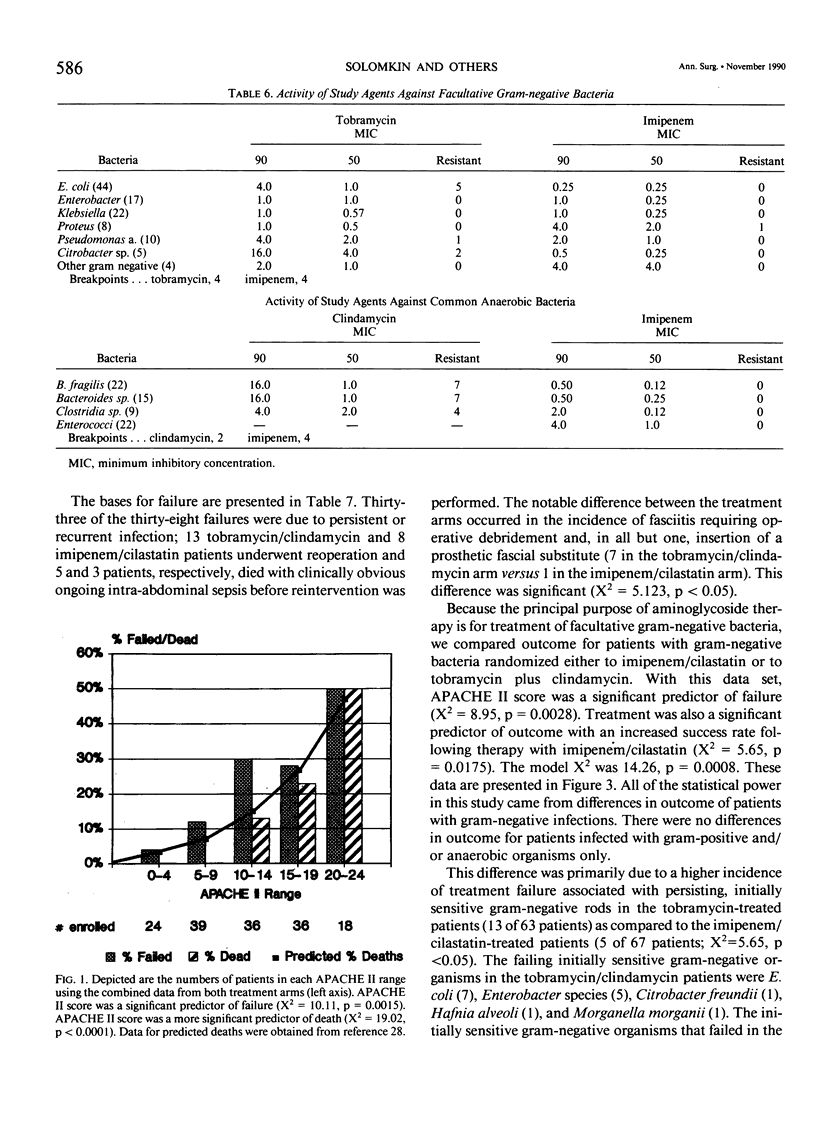
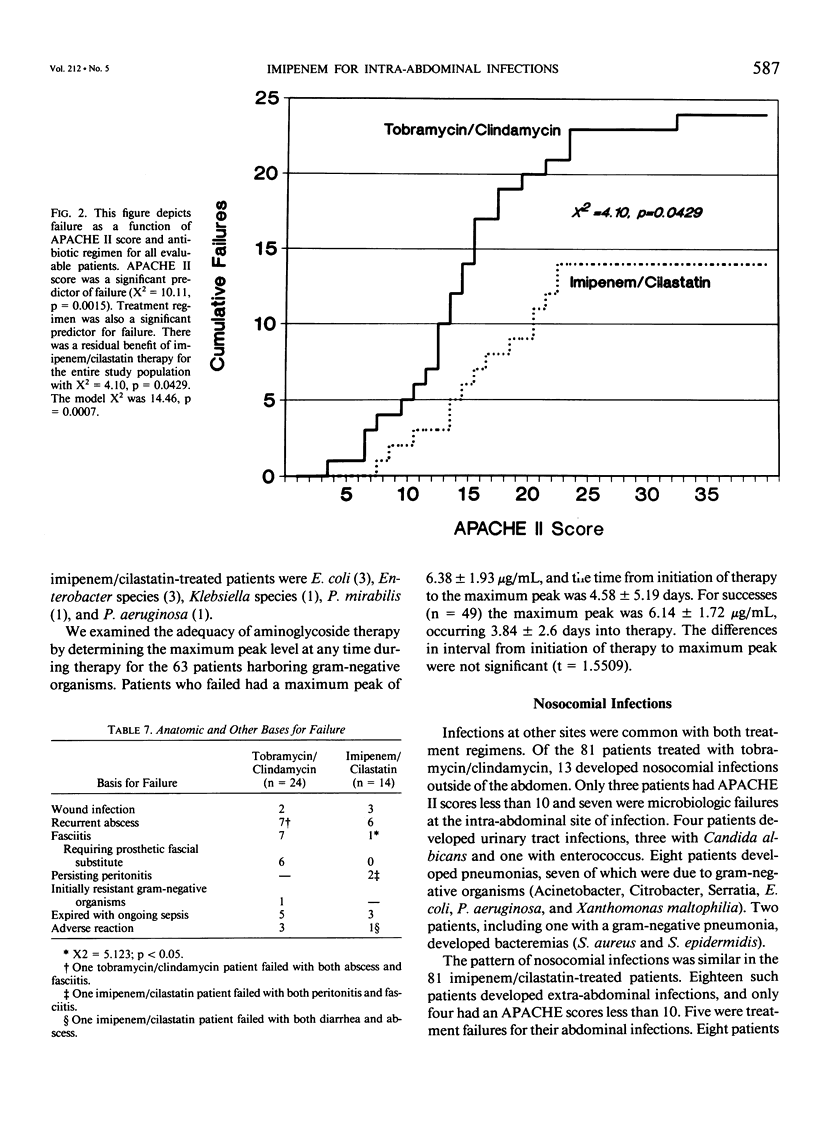
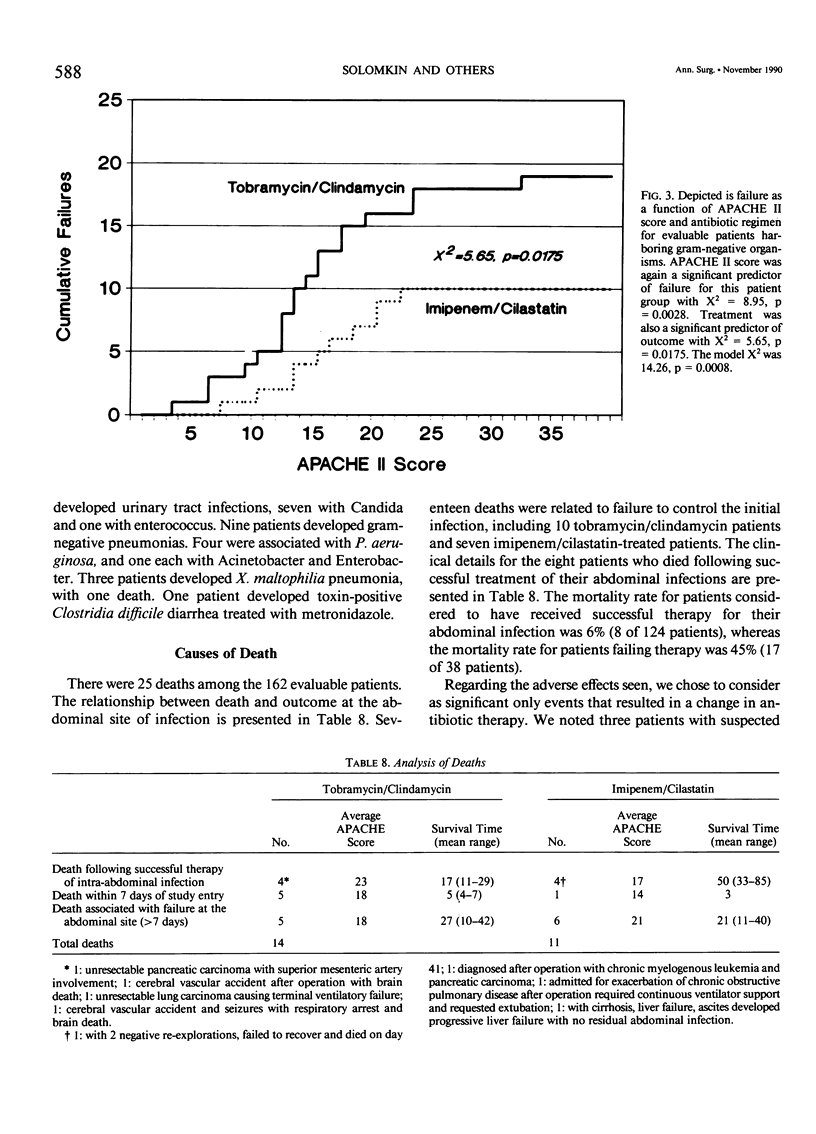

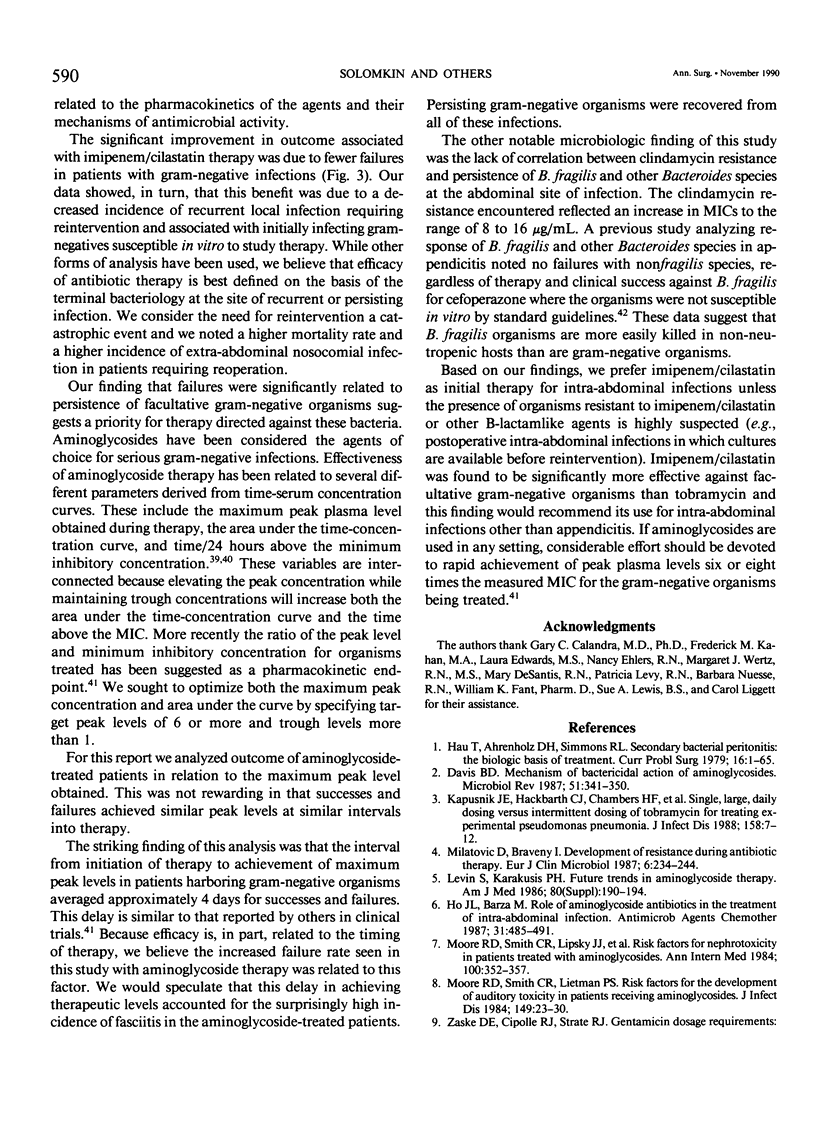
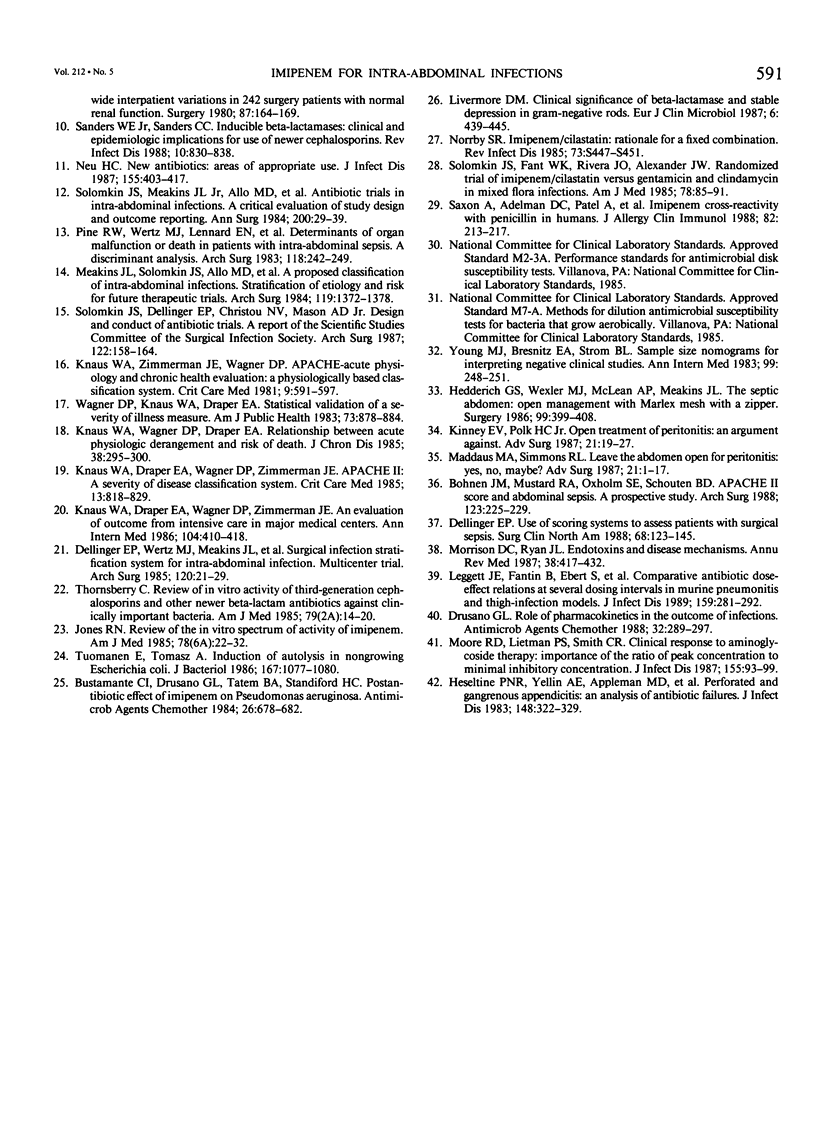
Selected References
These references are in PubMed. This may not be the complete list of references from this article.
- Bohnen J. M., Mustard R. A., Oxholm S. E., Schouten B. D. APACHE II score and abdominal sepsis. A prospective study. Arch Surg. 1988 Feb;123(2):225–229. doi: 10.1001/archsurg.1988.01400260113014. [DOI] [PubMed] [Google Scholar]
- Bustamante C. I., Drusano G. L., Tatem B. A., Standiford H. C. Postantibiotic effect of imipenem on Pseudomonas aeruginosa. Antimicrob Agents Chemother. 1984 Nov;26(5):678–682. doi: 10.1128/aac.26.5.678. [DOI] [PMC free article] [PubMed] [Google Scholar]
- Davis B. D. Mechanism of bactericidal action of aminoglycosides. Microbiol Rev. 1987 Sep;51(3):341–350. doi: 10.1128/mr.51.3.341-350.1987. [DOI] [PMC free article] [PubMed] [Google Scholar]
- Dellinger E. P. Use of scoring systems to assess patients with surgical sepsis. Surg Clin North Am. 1988 Feb;68(1):123–145. doi: 10.1016/s0039-6109(16)44436-1. [DOI] [PubMed] [Google Scholar]
- Dellinger E. P., Wertz M. J., Meakins J. L., Solomkin J. S., Allo M. D., Howard R. J., Simmons R. L. Surgical infection stratification system for intra-abdominal infection. Multicenter trial. Arch Surg. 1985 Jan;120(1):21–29. doi: 10.1001/archsurg.1985.01390250015003. [DOI] [PubMed] [Google Scholar]
- Drusano G. L. Role of pharmacokinetics in the outcome of infections. Antimicrob Agents Chemother. 1988 Mar;32(3):289–297. doi: 10.1128/aac.32.3.289. [DOI] [PMC free article] [PubMed] [Google Scholar]
- Hau T., Ahrenholz D. H., Simmons R. L. Secondary bacterial peritonitis: the biologic basis of treatment. Curr Probl Surg. 1979 Oct;16(10):1–65. doi: 10.1016/s0011-3840(79)80011-8. [DOI] [PubMed] [Google Scholar]
- Hedderich G. S., Wexler M. J., McLean A. P., Meakins J. L. The septic abdomen: open management with Marlex mesh with a zipper. Surgery. 1986 Apr;99(4):399–408. [PubMed] [Google Scholar]
- Heseltine P. N., Yellin A. E., Appleman M. D., Gill M. A., Chenella F. C., Kern J. W., Berne T. V. Perforated and gangrenous appendicitis: an analysis of antibiotic failures. J Infect Dis. 1983 Aug;148(2):322–329. doi: 10.1093/infdis/148.2.322. [DOI] [PubMed] [Google Scholar]
- Ho J. L., Barza M. Role of aminoglycoside antibiotics in the treatment of intra-abdominal infection. Antimicrob Agents Chemother. 1987 Apr;31(4):485–491. doi: 10.1128/aac.31.4.485. [DOI] [PMC free article] [PubMed] [Google Scholar]
- Jones R. N. Review of the in vitro spectrum of activity of imipenem. Am J Med. 1985 Jun 7;78(6A):22–32. doi: 10.1016/0002-9343(85)90098-1. [DOI] [PubMed] [Google Scholar]
- Kapusnik J. E., Hackbarth C. J., Chambers H. F., Carpenter T., Sande M. A. Single, large, daily dosing versus intermittent dosing of tobramycin for treating experimental pseudomonas pneumonia. J Infect Dis. 1988 Jul;158(1):7–12. doi: 10.1093/infdis/158.1.7. [DOI] [PubMed] [Google Scholar]
- Kinney E. V., Polk H. C., Jr Open treatment of peritonitis: an argument against. Adv Surg. 1988;21:19–27. [PubMed] [Google Scholar]
- Knaus W. A., Draper E. A., Wagner D. P., Zimmerman J. E. APACHE II: a severity of disease classification system. Crit Care Med. 1985 Oct;13(10):818–829. [PubMed] [Google Scholar]
- Knaus W. A., Draper E. A., Wagner D. P., Zimmerman J. E. An evaluation of outcome from intensive care in major medical centers. Ann Intern Med. 1986 Mar;104(3):410–418. doi: 10.7326/0003-4819-104-3-410. [DOI] [PubMed] [Google Scholar]
- Knaus W. A., Wagner D. P., Draper E. A. Relationship between acute physiologic derangement and risk of death. J Chronic Dis. 1985;38(4):295–300. doi: 10.1016/0021-9681(85)90075-x. [DOI] [PubMed] [Google Scholar]
- Knaus W. A., Zimmerman J. E., Wagner D. P., Draper E. A., Lawrence D. E. APACHE-acute physiology and chronic health evaluation: a physiologically based classification system. Crit Care Med. 1981 Aug;9(8):591–597. doi: 10.1097/00003246-198108000-00008. [DOI] [PubMed] [Google Scholar]
- Leggett J. E., Fantin B., Ebert S., Totsuka K., Vogelman B., Calame W., Mattie H., Craig W. A. Comparative antibiotic dose-effect relations at several dosing intervals in murine pneumonitis and thigh-infection models. J Infect Dis. 1989 Feb;159(2):281–292. doi: 10.1093/infdis/159.2.281. [DOI] [PubMed] [Google Scholar]
- Levin S., Karakusis P. H. Future trends in aminoglycoside therapy. Am J Med. 1986 Jun 30;80(6B):190–194. doi: 10.1016/0002-9343(86)90500-0. [DOI] [PubMed] [Google Scholar]
- Livermore D. M. Clinical significance of beta-lactamase induction and stable derepression in gram-negative rods. Eur J Clin Microbiol. 1987 Aug;6(4):439–445. doi: 10.1007/BF02013107. [DOI] [PubMed] [Google Scholar]
- Maddaus M. A., Simmons R. L. Leave the abdomen open for peritonitis: yes, no, maybe? Adv Surg. 1988;21:1–17. [PubMed] [Google Scholar]
- Meakins J. L., Solomkin J. S., Allo M. D., Dellinger E. P., Howard R. J., Simmons R. L. A proposed classification of intra-abdominal infections. Stratification of etiology and risk for future therapeutic trials. Arch Surg. 1984 Dec;119(12):1372–1378. doi: 10.1001/archsurg.1984.01390240010002. [DOI] [PubMed] [Google Scholar]
- Milatovic D., Braveny I. Development of resistance during antibiotic therapy. Eur J Clin Microbiol. 1987 Jun;6(3):234–244. doi: 10.1007/BF02017607. [DOI] [PubMed] [Google Scholar]
- Moore R. D., Lietman P. S., Smith C. R. Clinical response to aminoglycoside therapy: importance of the ratio of peak concentration to minimal inhibitory concentration. J Infect Dis. 1987 Jan;155(1):93–99. doi: 10.1093/infdis/155.1.93. [DOI] [PubMed] [Google Scholar]
- Moore R. D., Smith C. R., Lietman P. S. Risk factors for the development of auditory toxicity in patients receiving aminoglycosides. J Infect Dis. 1984 Jan;149(1):23–30. doi: 10.1093/infdis/149.1.23. [DOI] [PubMed] [Google Scholar]
- Moore R. D., Smith C. R., Lipsky J. J., Mellits E. D., Lietman P. S. Risk factors for nephrotoxicity in patients treated with aminoglycosides. Ann Intern Med. 1984 Mar;100(3):352–357. doi: 10.7326/0003-4819-100-3-352. [DOI] [PubMed] [Google Scholar]
- Morrison D. C., Ryan J. L. Endotoxins and disease mechanisms. Annu Rev Med. 1987;38:417–432. doi: 10.1146/annurev.me.38.020187.002221. [DOI] [PubMed] [Google Scholar]
- Neu H. C. New antibiotics: areas of appropriate use. J Infect Dis. 1987 Mar;155(3):403–417. doi: 10.1093/infdis/155.3.403. [DOI] [PubMed] [Google Scholar]
- Norrby S. R. Imipenem/cilastatin: rationale for a fixed combination. Rev Infect Dis. 1985 Jul-Aug;7 (Suppl 3):S447–S451. doi: 10.1093/clinids/7.supplement_3.s447. [DOI] [PubMed] [Google Scholar]
- Pine R. W., Wertz M. J., Lennard E. S., Dellinger E. P., Carrico C. J., Minshew B. H. Determinants of organ malfunction or death in patients with intra-abdominal sepsis. A discriminant analysis. Arch Surg. 1983 Feb;118(2):242–249. doi: 10.1001/archsurg.1983.01390020084014. [DOI] [PubMed] [Google Scholar]
- Sanders W. E., Jr, Sanders C. C. Inducible beta-lactamases: clinical and epidemiologic implications for use of newer cephalosporins. Rev Infect Dis. 1988 Jul-Aug;10(4):830–838. doi: 10.1093/clinids/10.4.830. [DOI] [PubMed] [Google Scholar]
- Saxon A., Adelman D. C., Patel A., Hajdu R., Calandra G. B. Imipenem cross-reactivity with penicillin in humans. J Allergy Clin Immunol. 1988 Aug;82(2):213–217. doi: 10.1016/0091-6749(88)91001-9. [DOI] [PubMed] [Google Scholar]
- Solomkin J. S., Dellinger E. P., Christou N. V., Mason A. D., Jr Design and conduct of antibiotic trials. A report of the Scientific Studies Committee of the Surgical Infection Society. Arch Surg. 1987 Feb;122(2):158–164. doi: 10.1001/archsurg.1987.01400140040004. [DOI] [PubMed] [Google Scholar]
- Solomkin J. S., Fant W. K., Rivera J. O., Alexander J. W. Randomized trial of imipenem/cilastatin versus gentamicin and clindamycin in mixed flora infections. Am J Med. 1985 Jun 7;78(6A):85–91. doi: 10.1016/0002-9343(85)90106-8. [DOI] [PubMed] [Google Scholar]
- Solomkin J. S., Meakins J. L., Jr, Allo M. D., Dellinger E. P., Simmons R. L. Antibiotic trials in intra-abdominal infections. A critical evaluation of study design and outcome reporting. Ann Surg. 1984 Jul;200(1):29–39. doi: 10.1097/00000658-198407000-00005. [DOI] [PMC free article] [PubMed] [Google Scholar]
- Thornsberry C. Review of in vitro activity of third-generation cephalosporins and other newer beta-lactam antibiotics against clinically important bacteria. Am J Med. 1985 Aug 9;79(2A):14–20. doi: 10.1016/0002-9343(85)90255-4. [DOI] [PubMed] [Google Scholar]
- Tuomanen E., Tomasz A. Induction of autolysis in nongrowing Escherichia coli. J Bacteriol. 1986 Sep;167(3):1077–1080. doi: 10.1128/jb.167.3.1077-1080.1986. [DOI] [PMC free article] [PubMed] [Google Scholar]
- Wagner D. P., Knaus W. A., Draper E. A. Statistical validation of a severity of illness measure. Am J Public Health. 1983 Aug;73(8):878–884. doi: 10.2105/ajph.73.8.878. [DOI] [PMC free article] [PubMed] [Google Scholar]
- Young M. J., Bresnitz E. A., Strom B. L. Sample size nomograms for interpreting negative clinical studies. Ann Intern Med. 1983 Aug;99(2):248–251. doi: 10.7326/0003-4819-99-2-248. [DOI] [PubMed] [Google Scholar]
- Zaske D. E., Cipolle R. J., Strate R. J. Gentamicin dosage requirements: wide interpatient variations in 242 surgery patients with normal renal function. Surgery. 1980 Feb;87(2):164–169. [PubMed] [Google Scholar]


